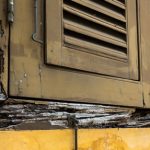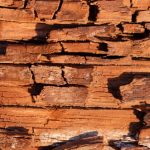What Causes Dry Rot
Dry rot occurs when the airborne spores come into contact with damp timber that has a moisture content of at least 20%. These spores then germinate and sprout grey root hyphae strands. The hyphae grow into mycelium which covers the timber in a thick cotton-wool like substance. The fungus eats the wood and sucks the moisture from it, leaving it weakened. The fungus then advances into a fruiting body known as sporophore which sprouts more spores to continue the life cycle.
The dry rot spores develop into the wood-destroying fungus as a result of damp timber and the fungus thrives in moist, damp, poorly ventilated conditions. There are many reasons why timber could be damp in the home, including penetrating damp, condensation, leaking pipes, faulty drainage, broken roof tiles, or a leaking washing machine, and this creates the ideal environment for fungi growth.
Identifying Dry Rot
The longer the dry rot is left untreated, the greater the damage it will cause to your home, so it is vitally important to identify the warning signs as soon as possible, and then early detection is key to eliminating the fungi.
Because the dry rot fungus likes dark and damp conditions, it is often found in non-visible areas such as under the stairs, in lofts and attics, in flooring or behind the plaster.
Look out for shrinking and warping timber caused by the removal of moisture from the wood.
Cuboidal cracking across the grain of the wood.
Also, a damp fungal smell.
Dry, brittle, and fractured wood that will crumble and break by hand.
Depending on what stage the dry rot is in its life cycle, it will show in a few different ways:
Spores – dry rot begins as a red-rust, orange, and brown-coloured spore dust.
Hyphae – once spores meet wet timber, the spore will germinate to produce hyphae which are identifiable by fine grey strands that grow through the timber.
Mycelium – hyphae multiply and generate mycelium growth which is characterised by a white or grey cotton-wool-like substance that spreads across masonry in search of wood for food.
Sporophore – this is the fungus’s mushroom fruiting body. It is rust-red and orange in colour and looks like a flat fleshy pancake. The sporophore releases new spores in order to begin the life cycle of the fungi again.
Treating Dry Rot
If you have identified any of the signs of dry rot in your property, you should act as soon as it is spotted and have a dry rot survey carried out to assess and inspect the full extent of the damage. If the surveyor finds that the rot is present, you will need to seek a dry rot specialist to remove the infestation. They will take the following steps to treat dry rot and rectify your home:
1. To eliminate fungal growth you need to first stop the source of the moisture. This can be any number of things including a leaking drainage pipe, condensation, faulty roof tiles, damp walls, a leaking shower tray or washing machine, penetration damp, or rising damp. Once you cut off the moisture, this prevents the fungus from feeding and growing.
2. Remove all infected timbers and damaged wood in the affected area including any skirting boards, panelling, and flooring.
3. Treat the existing structural timbers with a fungicide treatment to form a protective barrier against further fungi growth.
4. Replace the damaged wood with pre-treated timbers to prevent further infestation and eliminate future spores from germinating.
Trusted Timber Experts
Orchard Preservations has been offering reliable wet rot and dry rot treatment in the South West for over 20 years. With specialists available throughout regions such as Exeter, Chard, Newton Abbot, Dorset, Axminster and Taunton, our wide range of treatment options and methods make us the right choice of preservations service provider no matter what type of rot you are dealing with. Contact us today for a free quote.




